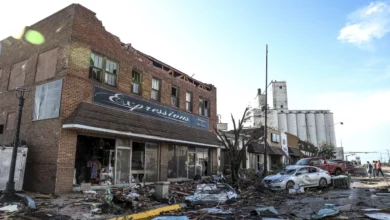
Rescuers battling heavy downpours plucked hundreds of people from rising floodwaters left in the wake of Hurricane Harvey, answering desperate calls for help all along the ravaged Texas coastline where at least two people were killed and up to 14 injured.
Anxiety ran high throughout the region between Corpus Christi and Houston because some of the most devastated areas were inaccessible to rescuers. And the forecast for days of steady rain threatened to inundate the region’s flat landscape, including Houston, with as much as 40 inches (100 centimeters).
Calls for water rescues swamped emergency workers early Sunday, the Houston Chronicle reported. Police evacuated two apartment complexes overnight in the Greenspoint neighborhood, rescuing more than 50 children from rising water.
“It breaks your heart,” Houston Police Chief Art Acevedo said as he stood in waist-high water during a livestream post on Twitter. “But it’s Texas. We’ll get through it.”
In the island community of Port Aransas, population 3,800, officials were unable to fully survey the town because of “massive” damage. Police and heavy equipment had only made it into the northernmost street.

“I can tell you I have a very bad feeling and that’s about it,” said Mayor Charles Bujan, who had called for a mandatory evacuation but did not know how many heeded the order.
Some of the worst damage appeared to be in Rockport, a coastal city of about 10,000 that was directly in the storm’s path. The mayor said his community took a blow “right on the nose” that left “widespread devastation,” including homes, businesses and schools that were heavily damaged. Some structures were destroyed.
Rockport’s roads were a mess of toppled power poles. A trailer blocked much of one major intersection. Wood framing from ripped-apart houses was strewn along Route 35 on the town’s southern end.
Harvey’s relentless wind tore the metal sides off the high school gym and twisted the steel door frame of its auditorium.
“We’re still in the very infancy stage of getting this recovery started,” said Aransas County spokesman Larry Sinclair.
One person was killed in Aransas County when in a fire at home during the storm, county Judge C.H. “Burt” Mills Jr. said.
Another person, a woman who tried to get out of her vehicle in high water, died in flooding in Harris County, where Houston is located, , though authorities had not confirmed a cause of death, said Gary Norman, a spokesman for the Houston emergency operations center.
As many as 14 people suffered minor injuries, including slips and falls, scrapes and a broken leg, Mills said.
About 300,000 customers were without power statewide. Gov. Greg Abbott said it would probably be several days before electricity is restored.
Meanwhile, the storm was barely moving. Rainfall totals varied across the region, with Galveston receiving around 8 inches (20 centimeters), Houston 11 (28 centimeters) and Aransas 10 (25 centimeters). Tiny Austwell got 15 inches (38 centimeters).
In Houston, authorities pleaded with people not to leave their homes as a flood emergency was declared.
“The streets are treacherous,” Houston Mayor Sylvester Turner said.
Elsewhere in the storm’s immediate aftermath, the Coast Guard had rescued 20 people from boats and barges in distress, said Capt. Tony Hahn, commander of the Corpus Christi sector.
The Corpus Christi port was closed with extensive damage. Because the city is the third-largest petrochemical port in the nation, the agency will be on the lookout for spills, Hahn said.
The fiercest hurricane to hit the U.S. in more than a decade came ashore late Friday about 30 miles (48 kilometers) northeast of Corpus Christi as a mammoth Category 4 storm with 130 mph (209 kph) winds.
Harvey weakened to a tropical storm by midday Saturday.
By 7 a.m. Sunday, Harvey was centered about 65 miles southeast of San Antonio, with maximum sustained winds of about 45 mph (72.42 kph), according to the National Hurricane Center, which described the flooding as “catastrophic.”
The hurricane posed the first major emergency management test of President Donald Trump’s administration.
Trump met with his Cabinet and other senior administration officials to discuss the federal response to the damage and flooding, the White House said Saturday in a statement.
The president held a video conference from Camp David in which he instructed departments and agencies to “stay fully engaged and positioned to support his number one priority of saving lives,” the statement said.
Trump, who on Friday signed a federal disaster declaration for coastal counties, also reminded department heads that the full impact of the storm will not be apparent for days.
South of the city, about 4,500 inmates were evacuated from three state prisons in Brazoria County because the nearby Brazos River was rising.
The turbulent weather extended into southern Louisiana, where motorists were cautioned about the potential for high water, road hazards, high winds and tornadoes.
Harvey came ashore as the fiercest hurricane to hit the US in 13 years and the strongest to strike Texas since 1961′s Hurricane Carla, the most powerful Texas hurricane on record.
The storm’s approach sent tens of thousands of people fleeing inland.
Just hours before landfall, the governor and Houston leaders issued conflicting statements on evacuation.
The governor urged more people to flee, but Houston officials recommended no widespread evacuations, citing greater danger in having people on roads that could flood and the fact that the hurricane was not taking direct aim at the city.
The last Category 4 storm to hit the U.S. was Hurricane Charley in August 2004 in Florida.




